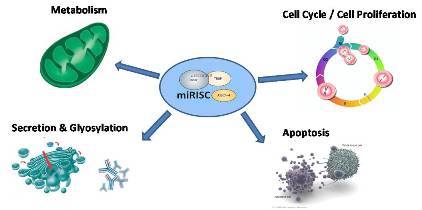MicroRNOMics of CHO host and production cell lines
SUPERVISOR: JOHANNES GRILLARI
Project assigned to: VAIBHAV JADHAV
Background.
Over the past few years our research was focused on genomic and proteomic analyses of various primary human cells such as umbilical vein endothelial cells (Grillari et al., 2000; Hampel et al., 2006), fibroblasts and fibroblastoid cells (Voglauer et al., 2005), epithelial kidney cells, and CHO cell lines (Grillari et al., 2001). In order to functionally characterize some of the proteins involved in the regulation of cell proliferation, senescence and stress resistance, we started to characterize the novel protein SNEV, a conserved splicing factor (Grillari et al., 2005) and proteasome interacting protein (Löscher et al., 2005), that extends cellular life span (Voglauer et al., 2006). In a logical extension of our genomic and proteomic efforts to unravel molecular mechanisms underlying transcriptional control of gene expression, we recently started analysing the miRNA profiles in human endothelial cells. MicroRNAs are a novel category of highly relevant molecules that have recently emerged as regulators of a broad range of physiological functions like developmental timing, regulation of cell proliferation, cellular metabolism, and stress resistance. Around 1000 miRNAs have been identified so far, but still only very few have been functionally characterized. However, it seems to be clear that some miRNAs regulate a large quantity of target genes. Interestingly, only one report has been published so far on CHO miRNAs, but without addressing functional questions (Gammel et al., 2007). We recently proposed how miRNAs might be used in engineering of cell factories (Müller et al., 2008).

Aims and methods.
Here, we propose to
(i) perform deep sequencing of the miRNAs present in CHO cells using the Illumina technology that is perfectly suited for small RNA sequencing (Morin et al., 2008). In order to identify the vast majority of potentially expressed miRNAs we will generate libraries from different CHO cell lines (K1, DHFR-) under different conditions (serum containing media, shear, cold and heat shock, oxidative stress, hypoxia, addition of sodium butyrate) using the Illumina small RNA library preparation kit. This deep sequencing will be complemented by a paired end deep sequencing using the Roche 454 technology of all mRNAs of cDNA libraries of the same origin as the small RNA libraries. This will allow to compare the miRNAs to potential seed sequences on the mRNAs in collaboration with KREIL.
(ii) After annotation of the CHO miRNAs by searching for conserved miRNAs but also by comparing the identified putative miRNAs to the mouse and rat genomes, we will be able to produce CHO-specific micro-arrays that will allow the establishment of miRNA transcriptome profiles as “diagnostic” tool of “high potential” (with respect to protein production, protein quality, stress resistance) versus “low potential” host and producer cells. For preliminary experiments a cross-species approach as already successfully applied for mRNA expression profiling (Ernst et al., 2006), will be performed.
(iii) The miRNAs thus identified will be functionally characterized in producer cell lines. For this, we will transfect producer cells with “candidate miRNAs”. The selected miRNAs will be those that respond in their expression levels to production-relevant stresses and are known or suspected to regulate gene-networks of cellular proliferation, stress and apoptosis resistance, as well as secretion.
The identification and functional analysis of miRNAs that are differentially expressed in different host and producer cell lines will lead to knowledge-based CHO cell engineering strategies. This will improve the bioindustrially relevant characteristics of CHO cells, which are one of the most important biopharmaceutical cell factories.
Grillari, J., Hohenwarter, O., Grabherr, R. M., Katinger, H. (2000) Exp. Gerontol. 35, 187-197
Hampel, B., Fortschegger, K., Ressler, S., Chang, M. W., Unterluggauer, H., Breitwieser, A., Sommergruber, W., Fitzky, B., Lepperdinger, G., Jansen-Durr, P., Voglauer, R., Grillari, J. (2006) Exp. Gerontol. 41, 474-481
Voglauer, R., Grillari, J., Fortschegger, K., Wieser, M., Sterovsky, T., Gunsberg, P., Katinger, H., Pfragner, R. (2005) Int. J. Oncol. 26, 961-970
Grillari, J., Fortschegger, K., Grabherr, R. M., Hohenwarter, O., Kunert, R., Katinger, H. (2001) J. Biotechnol. 87, 59-64
Grillari, J., Ajuh, P., Stadler, G., Loscher, M., Voglauer, R., Ernst, W., Chusainow, J., Eisenhaber, F., Pokar, M., Fortschegger, K., Grey, M., Lamond, A. I., Katinger, H. (2005) Nucleic Acids Res. 33, 6868-6883
Loscher, M., Fortschegger, K., Ritter, G., Wostry, M., Voglauer, R., Schmid, J. A., Watters, S., Rivett, A. J., Ajuh, P., Lamond, A. I., Katinger, H., Grillari, J. (2005) Biochem. J. 388, 593-603
Voglauer, R., Chang, M. W., Dampier, B., Wieser, M., Baumann, K., Sterovsky, T., Schreiber, M., Katinger, H., Grillari, J. (2006) Exp. Cell Res. 312, 746-759
Gammell, P., Barron, N., Kumar, N., Clynes, M. (2007) J. Biotechnol. 130, 213-218
Müller, D., Katinger, H., Grillari, J. (2008) Trends Biotechnol. 26, 359-365
Morin, R. D., O'Connor, M. D., Griffith, M., Kuchenbauer, F., Delaney, A., Prabhu, A. L., Zhao, Y., McDonald, H., Zeng, T., Hirst, M., Eaves, C. J., Marra, M. A. (2008) Genome Res. 18, 610-621
Ernst, W., Trummer, E., Mead, J., Bessant, C., Strelec, H., Katinger, H., Hesse, F. (2006) Biotechnol. J. 1, 639-650
